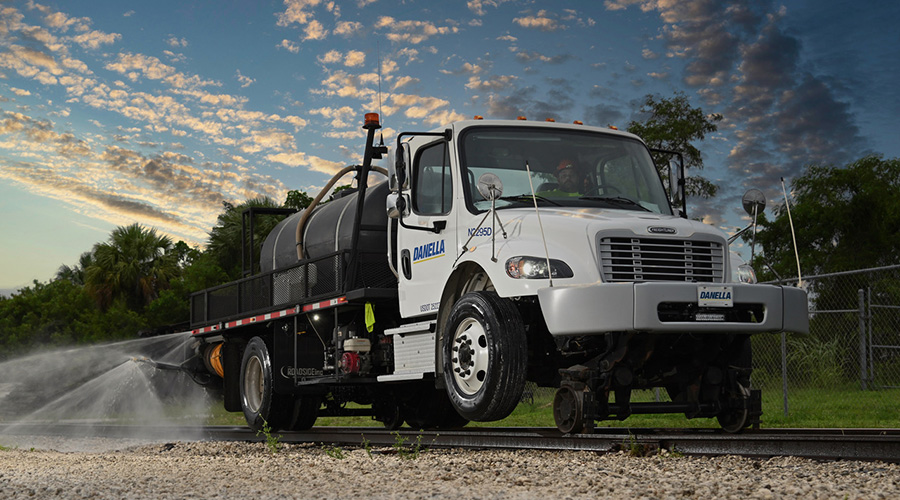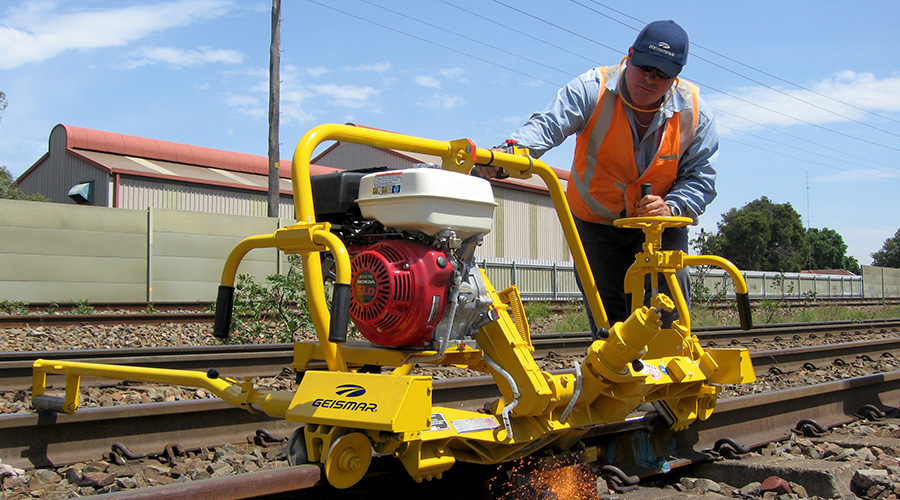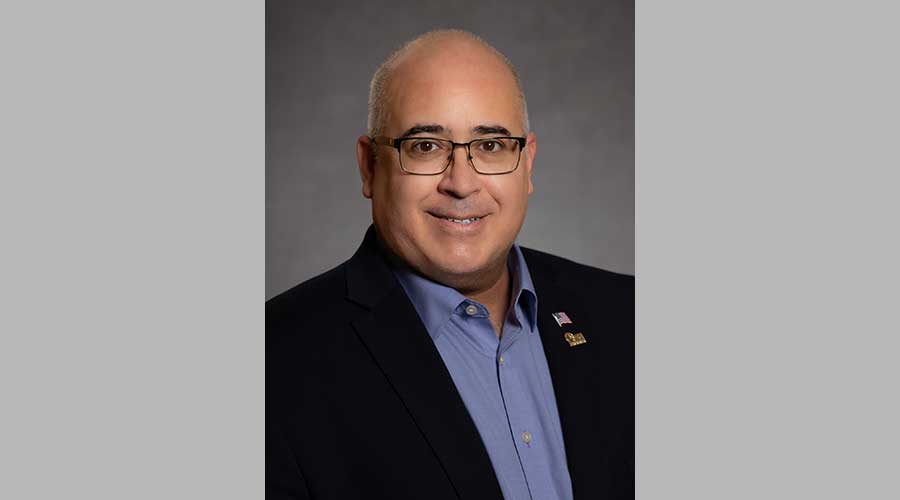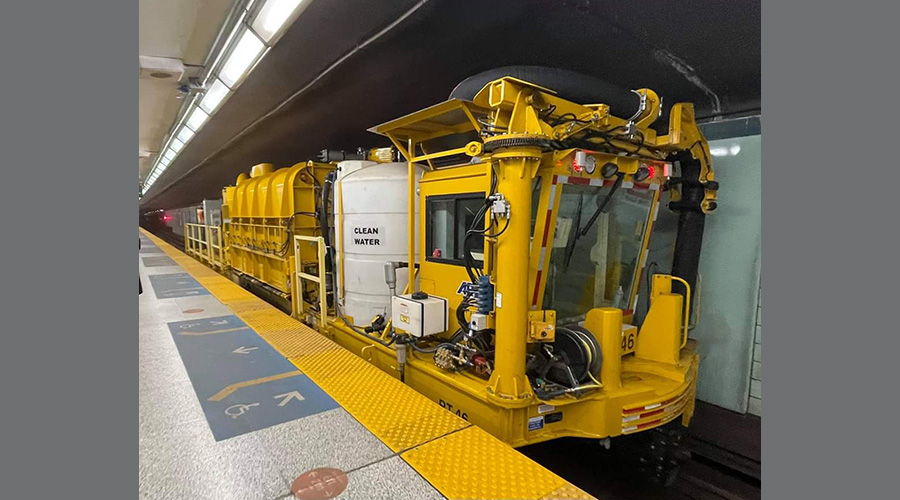2010 MOW Plans (by budget amount)
BNSF Railway Co.
2010 MOW (total capital spending) budget: $2.4 billion, includes expansion capital and locomotive acquisitions, not just replacement capital
2009 MOW (total capital spending) budget: $2.6 billion, includes expansion capital and locomotive acquisitions, not just replacement capital
Reason for decrease: Fewer expected locomotive acquisitions.
Rail: Replace or install 835 track miles of rail.
Ties: Replace or install 2.8 million wood, 160,000 concrete and 100,000 plastic ties.
PTC work: Capex includes funds for PTC, but details have not been publicly disclosed.
(Note: BNSF declined to provide other MOW data.)
Union Pacific Railroad
2010 MOW budget: About $1.6 billion 2009 MOW budget: About $1.7 billion Reason for decrease: UP continues to maintain a robust maintenance program.
Rail: Install or replace about 800 miles of new or secondhand continuous-welded rail (CWR).
Ties: Replace or install 3.6 million wood, 380,000 concrete and 170,000 composite ties.
Ballast: Install 5.1 million tons.
Grinding/surfacing: Grind 21,778 pass miles; surface 9,500 miles.
Bridge work: Overall budget is equal to 2009's at about $110 million; continue to upgrade wooden bridges to concrete/steel, replacing nearly 12,500 feet.
PTC work: UP has budgeted about $200 million for PTC in 2010.
CN
2010 MOW budget (includes signals & communications, bridge investments): $834 million
2009 MOW budget (included signals & communications, bridge investments): $830 million
Reason for slight increase: Overall capital investment is flat year over year, taking into account planned productivity gains for MOW rail and tie programs in 2010.
Rail: Install 275 track miles of new CWR and 200 track miles of secondhand rail (90 percent will be laid as CWR).
Double track: As part of VIA Rail Canada Inc.'s two-year CN Kingston Subdivision project (including track, bridge and signal work in 2010 and 2011), CN will construct 35 miles of double track in the subdivision between Montreal, Quebec and Toronto.
Sidings: Extend various sidings network-wide to boost capacity, including two in Northern Ontario, two in the Western Region west of Prince George and two planned in the Winnipeg-to-Chicago corridor due to continued growth.
Ties: Install 1.75 million wood and 50,000 concrete ties.
Ballast: Install 2 million tons.
Grinding/surfacing: Surface 9,000 miles.
Bridge work: Spend $90 million on planned bridge rebuild projects systemwide.
PTC work: PTC work planned in 2010, but funded separately from basic capital budget.
CSX Transportation
2010 MOW budget: $763 million
2009 MOW budget: $765 million
Reason for slight decrease: "Smart" purchasing decisions and "Trackworks" productivity, combined with an increased relay rail program will serve to keep year-over-year unit costs in check.
Rail: Replace or install 550 miles with CWR.
Ties: Replace or install 3.2 million wood ties.
Ballast: Install 3.7 million tons.
Grinding/surfacing: Grind 18,000 miles; surface 5,800 miles.
Bridge work: Continue to alter the 14-Mile Bridge over Mobile River near Mobile, Ala., replace existing swing span with a vertical lift span, $72 million, awarded $60 million contract to Scott Bridge Co. in September 2009, to be completed in late 2011 (see article at left).
PTC work: Budget $170 million in 2010, with $750 million budgeted through 2015.
Norfolk Southern Corp.
2010 MOW budget: $696 million
2009 MOW budget: $706 million
Reason for decrease: Difference is 58 miles of additional new rail and 160,000 additional ties added to 2009 program to continue to invest in physical plant, and take advantage of productivity driven by increased track time, as well as a motivated workforce.
Rail: Install 266.3 miles of new CWR and 75 miles of relay rail.
Sidings: Extend existing 8,900-foot siding in Jacksonville, Fla.; build two new 9,300-foot sidings in Burnside, Ky.; and construct new 12,000-foot siding in Selma, Ala.
Ties: Install 2.3 million new wood ties and 300,000 relay ties.
Ballast: Install 2.9 million tons.
Grinding/surfacing: Total budget of $12 million for grinding; surface 2,280 miles.
Bridge work: Allocated $51.9 million for bridge projects, including replacement of wooden trestles with concrete ballast-deck bridges, steel and culvert replacements, and installation of 25,000 bridge ties.
PTC work: $29.4 million budgeted for PTC out of C&S capital budget.
Canadian Pacific
2010 MOW budget: $575.5 million (basic replacement)
2009 MOW budget: N/A
Rail: Install about 270 track miles of new CWR and 155 track miles of secondhand CWR.
Double/triple track: 9,500-foot extension in Canoe, B.C. (grading in 2010/construction in 2011); 12,595-foot extension in Ballaston, N.Y. (grading in 2010/construction in 2011).
Sidings: Extend 2,700-foot siding and upgrade 8,300 feet in Bolton, Ont.; extend 15,000-foot siding in Ypres, Ont. (design and grading in 2010/construction in 2011).
Ties: Install 820,000 new wood, 28,000 secondhand wood, 1,400 steel and 750 concrete ties.
Ballast: Install 736,000 tons.
Grinding/surfacing: Total of about 11,600 pass miles.
Bridge work: Four largest bridge projects in 2010 include one span replacement in Merriam Subdivision, one span replacement in Weyburn Subdivision and two span replacements in Watertown Subdivision; total cost of $11.8 million.
PTC work: About $14.8 million budgeted for PTC in addition to basic replacement capital.
The Kansas City Southern Railway Co./Kansas City Southern De México s.a. de c.v. (combined data)
2010 MOW budget: Total capex will be in range of 15 percent to 17 percent of total revenue. Maintenance capital is about 55 percent to 60 percent of total capex.
2009 MOW budget: N/A
Rail: Install 97 miles of CWR.
Ties: Install 570,000 wood and 143,000 concrete ties.
Grinding/surfacing: Total of 4,000 miles
Facility projects: Building renovation in Monterrey, Mexico.
PTC work: KCS estimates the company will spend $100 million over six-year span for PTC, an allocation that will stay within guidelines of 15 percent to 17 percent of total revenue.
|


 LRW Honors Amtrak’s Acheson As Railway Woman Of The Year
LRW Honors Amtrak’s Acheson As Railway Woman Of The Year
 From Editor-In-Chief Foran: Of Gender Equity And Inclusion
From Editor-In-Chief Foran: Of Gender Equity And Inclusion
 Spotlight On Some Of Today’s Rail Safety Products
Spotlight On Some Of Today’s Rail Safety Products
 Women of Influence in Rail eBook
Women of Influence in Rail eBook
 railPrime
railPrime







